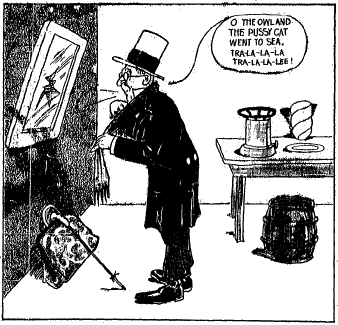Nonsense in the Early Comics
Nonsense was one of the central ingredients in the comics supplements of the early 1900s. This should not be surprising as the children’s literature of the age had its roots in the great classics of the previous century and comics were increasingly being addressed to children, after starting out as a “vulgar” pastime for uneducated adults.
Lewis Carroll’s Alice books were obviously the dominating influence and several strips were clearly influenced by them, from Alice in Funnyland (1901-1903) – only slightly related to the original – to Winsor McCay’s classics, Little Nemo in Slumberland and Dreams of a Rarebit Fiend.
Edward Lear’s limericks also supplied a model of text-image integration which could be easily imitated and lent itself to endless replication with slight variations, just what was needed by a medium bound to a strict publishing schedule. The continuing interest of the public for the limerick, in addition, guaranteed the participation of many would-be poets who could hope to see their compositions published.
The first strips presented here are both limerick sequences, though quite different from each other: JP Benson‘s The Woozlebeasts follows Lear’s example and provides a series of unrelated poem-picture sets (six per week) while Gustave Verbeek’s The Loony Lyrics of Lulu is a more typical comic strip and presents a new, but highly repetitive, story every week which contains a limerick, sometimes authored by the readers.
ToC

The post you are looking for is from my Blog of Bosh, a separate site:
https://nonsenselit.wordpress.com/2009/01/27/de-kat-en-de-uil/
Unfortunately there is not much more than what you already found in the post you link to, except a link to the Regionaal Archief Alkmaar which no longer works, thought he institution probably still has the original.